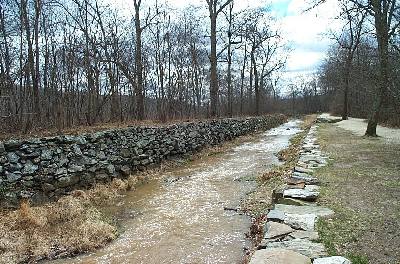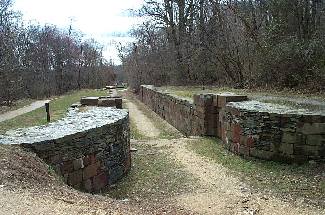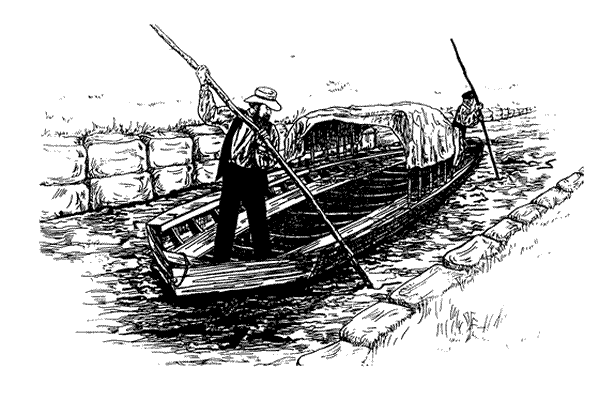The Patowmack Canal Park
Few ventures were dearer to George Washington than his plan to make the Potomac River navigable as far as the Ohio River Valley. In the uncertain period after the Revolutionary War, Washington believed that better transportation and trade would draw lands west of the Allegheny Mountains into the United States and "...bind those people to us by a chain which never can be broken."
"The way," Washington wrote, "is easy and dictated by our clearest interest. It is to open a wide door, and make a smooth way for the produce of that Country to pass to our Markets ...."
As a waterway west the Potomac River could be that "door." It was the shortest route between tidewater, with access to East Coast and trans-Atlantic trade, and the headwaters of the Ohio River, with access to the western frontier. But both political and physical obstacles had to be overcome.
Opening the Potomac required cooperation of Virginia and Maryland, which bordered the river. In 1784, Washington convinced the states' assemblies to establish a company to improve the Potomac between its headwaters near Cumberland, Md., and tidewater at Georgetown. The Patowmack Company, organized May 17, 1785, drew directors and subscribers from both states. The office of president, Washington wrote in his diary, "fell upon me." He presided over the project until he became the nation's chief executive.
 Delegates from Virginia and Maryland, meeting at Washington's home in
1785, drew up the Mount Vernon Compact, providing for free trade on the
river. Virginia and Maryland legislators ratified the compact and then
invited all 13 states to send delegates to a convention in Annapolis
in 1786 "to consider how far a uniform system in their commercial regulations
may be necessary to their common interest." The Annapolis Convention
led to a general meeting in Philadelphia the following May. Thus, George
Washington's lobbying for interstate cooperation on the Potomac helped
prepare the way for the Constitutional Convention of 1787.
Delegates from Virginia and Maryland, meeting at Washington's home in
1785, drew up the Mount Vernon Compact, providing for free trade on the
river. Virginia and Maryland legislators ratified the compact and then
invited all 13 states to send delegates to a convention in Annapolis
in 1786 "to consider how far a uniform system in their commercial regulations
may be necessary to their common interest." The Annapolis Convention
led to a general meeting in Philadelphia the following May. Thus, George
Washington's lobbying for interstate cooperation on the Potomac helped
prepare the way for the Constitutional Convention of 1787.
The Potomac presented physical obstacles to travel as well. Narrow and winding in places, it drops over 600 feet in 200 miles from Cumberland to sea level. Spring rains swell the river to dangerous heights; summer droughts can render it impassable. To make the river navigable by even shallow draft boats, the Patowmack Company had to dredge portions of the riverbed and skirt five areas of falls.
By far the most demanding task was building a canal with locks to bypass the Great Falls of the Potomac. Roaring over the rocks, the river drops nearly 80 feet in less than a mile.
 Swift currents, solid rock, and constant financial and labor problems hindered
progress on the Patowmack Canal at Great Falls.
Swift currents, solid rock, and constant financial and labor problems hindered
progress on the Patowmack Canal at Great Falls.
Construction begun in 1785 and took seventeen years to complete - six years longer than the time required to locate, build, and begin occupying a new federal city, Washington, D.C., ten miles down river.
Like a steep stairway, a series of five locks raised or lowered boats around the falls. Construction required engineering skills and a labor force not easily found in 18th century America. Crews consisted of unskilled laborers, skilled indentured servants, and slaves rented from nearby plantations. The work was difficult and dangerous. With one of the earliest uses in this country of black-powder blasting, workers forced a channel through the rock cliffs for the final three locks.
An entire town grew up around the construction site to serve as headquarters for the Patowmack Company and home for the workers. The town was named Matildaville by its founder, the Revolutionary War hero "Light Horse" Harry Lee. Harry Lee, the father of Robert E. Lee, named the town for his first wife, Matilda Lee. Matildaville, at its height, boasted the company superintendent's house, a market, gristmill, sawmill, foundry, inn, ice house, workers' barracks, boarding houses, and a sprinkling of small homes. Boaters stopped here to wait their turn through the locks, to change cargo, or to enjoy an evening in town before continuing their journey.

Thousands of boats locked through at Great Falls, carrying flour, whiskey, tobacco, and iron downstream; carrying cloth, hardware, firearms, and other manufactured products upstream. Vessels varied from crudely constructed rafts to the long narrow "sharper," a keelboat that could carry up to 20 tons of cargo. The trip took 3 to 5 days down to Georgetown and 10 to 12 days poling against the current back to Cumberland.
Built to support the canal industry, Matildaville's fate was tied to that of the Patowmack Company. Today, only a few fragile remains of Matildaville are visible.
The greatest obstacle to the Patowmack project proved to be financial. High construction costs, particularly at the Great Falls section, and insufficient revenues bankrupted the company. Extremes of high and low water restricted use of the canal to only a month or two each year. The tolls collected could not even pay interest on the company debt.
The Patowmack Company succumbed in 1828, turning over its assets and liabilities to the newly formed Chesapeake and Ohio Canal Company. The new company abandoned the Patowmack Canal in 1830 for an even more ambitious undertaking: a man-made waterway stretching from Georgetown to Cumberland on the Maryland side of the river.
Although the Patowmack Company was a financial failure, its builders
pioneered lock engineering and stimulated a wave of canal construction
important to the country's development.

George Washington did not live to see the completion of the navigation project that had been his obsession since youth. But he did take pride in visiting the canal during the construction to inspect its progress. He died in 1799, two years before the canal opened at Great Falls. But in the long run Washington's vision of a strong nation linked by trade came true. His frequent toast, "Success to the navigation of the Potomac!" became a footnote of American history.
In 1930 Congress authorized this place of human history and natural beauty as a park. The National Park Service took on responsibility for its management in 1966.
The preservation of the Patowmack Canal is part of the Park Service's continuing efforts to protect and preserve special resources of the park. The Patowmack Canal and Matildaville ruins are protected by the Archeological Resources Protection Act of 1979. This law prohibits excavation, removal, or displacement of archeological resources.
(Text and pictures courtesy of the National Park Service.)